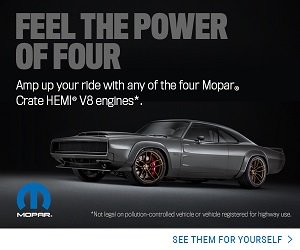The year was 1970, and NHRA had a brand-new door slammer eliminator comprised of vehicles similar in appearance to the muscle cars driven off the dealership showroom floors…Pro Stock. The most dominant Pro Stocker in the four-speed era (1970-72) was the team of Ronnie Sox (driver) and Buddy Martin (team manager), better known as Sox & Martin.
Before the creation of Pro Stock, Sox & Martin ran a fleet of Plymouths in Stock, Super Stock, Modified Production, and even the early altered-wheel base factory experimental funny cars. They had plenty of wins in those classes, but it was Pro Stock where Sox & Martin, along with chief mechanic Jake King’s prepared Hemis, made their name by dominating the first two years of the class with nine wins at fifteen contested NHRA events. With a Hemi-equipped ‘Cuda, Sox was able to win the inaugural NHRA Pro Stock championship.
To limit Sox & Martin’s success, NHRA, in 1972, began changing class weight breaks for the Hemi cars. The Hemi cars gained weight faster than a college freshman, and because of the constant weight increases, the Hemi cars became non-competitive at NHRA events, with only one race win (Carlton). So gifted was Sox with a four-speed shifter and clutch pedal, the team lost another advantage in 1973.
The competition adopted the clutchless Lenco transmission, in an attempt to reduce driveline carnage. While his competitors quickened their elapsed times, Sox was consistently .04-seconds slower in the quarter-mile with the Lenco. Racing for Chrysler soured even further. Corporate financial complications forced Chrysler to pull their Pro Stock program support in 1974. By 1975, Sox & Martin dissolved the team and put their racing business up for sale.
During their heyday, Sox & Martin participated in the wildly successful Plymouth Supercar Clinics, which provided technical data and driving tips to local Mopar enthusiasts through the vast North American Plymouth dealer network. After the breakup of Sox & Martin, Sox continued to be a hired gun for other race teams. In the 1990s, Sox & Martin reconnected with a Pro Stock Truck effort, but the team never experienced the same success as their initial Pro Stock years.
In the mid-1960s, “Gentleman Joe” Schubeck, a former Top Fuel racer, and chassis builder, formed Lakewood Industries in Lakewood, Ohio. Racer safety was at the forefront of all the components the company designed and sold. An example of their high-performance safety equipment is the Lakewood Hydroformed Safety Bell Housing described in this June 1970 Hot Rod ad. Sox & Martin installed Lakewood quality into their 1970 ‘Cuda to protect “Mr. Four-Speed” from a possible injury as a result of a catastrophic clutch failure.
Lakewood, now under the Holley umbrella, continues to design and manufacture quality bell housings like the one used by Sox & Martin. The same exhaustive research and testing established in the 1960s continue with the business today. Lakewood offers industry-leading bell housings, drag shocks, traction bars, driveshaft loops, and chassis components. For more information about their safety products for your Mopar, check out Lakewood.















 Mopar Connection Magazine – The ONLY Daily Mopar Magazine © 2022. All Rights Reserved. Mopar Connection Magazine is the ONLY daily Mopar Magazine bringing you the latest Mopar news, technology, breaking news, and Mopar related events and articles. Find out the latest information about Mopar, Mopar products and services, stay up to date on Mopar enthusiast news, dealership information and the latest Mopar social media buzz! Sign up for the Mopar Connection Magazine newsletter for the latest information about new products, services and industry chatter. Mopar Connection Magazine is the best and only source you need to be a Mopar industry insider!
Mopar Connection Magazine – The ONLY Daily Mopar Magazine © 2022. All Rights Reserved. Mopar Connection Magazine is the ONLY daily Mopar Magazine bringing you the latest Mopar news, technology, breaking news, and Mopar related events and articles. Find out the latest information about Mopar, Mopar products and services, stay up to date on Mopar enthusiast news, dealership information and the latest Mopar social media buzz! Sign up for the Mopar Connection Magazine newsletter for the latest information about new products, services and industry chatter. Mopar Connection Magazine is the best and only source you need to be a Mopar industry insider! by
by